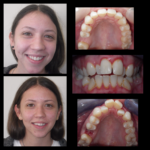Malocclusion is a dental condition where the teeth are misaligned in such a way that the upper and lower jaws do not close properly. This condition can affect regular activities like chewing and eating and trigger oral health problems. Malocclusion is one of the most common health problems, and it can affect people in different degrees that range from mild to extremely severe. One particular adverse affect of this condition is periodontal disease.
• Malocclusion makes it difficult to remove plaque and food particles that are stuck between misaligned teeth. This can lead to redness of the gums and bleeding while brushing your teeth or flossing.
• Over time, the bacteria that breed on the plaque and food particles will enter inside the body through the blood, resulting in bacterial infections and tooth degradation.
• Plaque may also cause bad breath or halitosis, which results in gum inflammations.
• Badly aligned teeth create a lot of pressure on your teeth and jaws. The teeth subjected to unnatural strain can get chipped, and notches in the gum line called ‘abfractions’ can surface.
• Untreated gum inflammation can lead to damage of soft tissue, receding gums, and lead to pocket formation between the teeth and gums, resulting in bone loss.
• Continuous strain can result in poor root support and loosen your teeth, and you may lose one or more teeth as a result.
• In more serious cases, periodontal disease can increase the risk of atherosclerosis or hardening of the arteries.
As you can see, malocclusion is not a problem about aesthetic appeal. It can be a serious dental health problem as well, leading to periodontal disease, dental caries, headaches and tooth pain. Some people have no symptoms at all, while others suffer from several symptoms.

Treatment of malocclusions:
Orthodontic treatment using appliances can help put the teeth back into their normal position slowly and help in teeth straightening. The flip side of wearing appliances is that they decalcify teeth and can result in enamel opacities on the labial surfaces of the teeth. However, wearing dental braces or other appliances is the only way to treat malocclusions and is worth the effort if you maintain proper dental hygiene.
